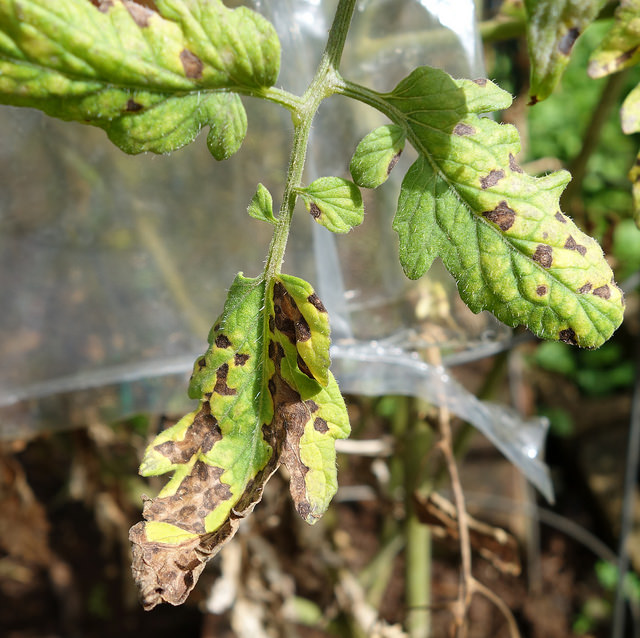Introduction
Septoria leaf spot, also called septoria leaf blight, septoria leaf blotch, septoria leaf canker, and tomato leaf spot, is a fungal disease that infects several important economic plants, as well as solanaceous weeds. It is one of the most serious diseases of tomato plants. Infected plants are partially to completely defoliated. This increases their exposure to the sun, which can cause them to incur sunscald damage. Infected plants are often rendered unsuitable for consumption. When infections are prevalent, gardens may experience a drastic reduction in crop yield.
Distribution & Habitat
Septoria leaf spot occurs globally, wherever susceptible plants are present.
Hosts
Septoria leaf spot attacks tomatoes, potatoes, and eggplants. It also frequently infects solanaceous weeds. Some of the most commonly infected solanaceous weeds include black nightshade, jimsonweed, horsenettle, and smooth groundcherry. Vulnerable plants may be infected through their leaves, seeds, or rhizomes.
Disease Cycle
The disease pathogen overwinters on infected plant debris, or on structural planting equipment. In spring, once conditions are sufficiently moist, small, dark brown fruiting structures called pycnidia arise on infected leaves. When the fruiting bodies have reached maturity, they rupture, and expel spores, which are disseminated by air currents, splashes of rain, or insect vectors to nearby plants, which they readily infect. The spores germinate in leaves they have infected within 48 hours. Once a plant is infected, the disease advances up the stem, with all the leaves it infects dying, before being prematurely cast. Septoria leaf spot infections may occur throughout the growing season. Prolonged, wet conditions are conducive to the development and spread of the pathogen. Infections are most prevalent when temperatures are between 60°F and 80°F.
Symptoms of Infection
Small, water-soaked spots appear on the underside of lower leaves. On infected crops, this occurs after the crop has established its root system. The spots, or lesions, are circular, and initially measure 1/16 to 1/8 inch in diameter. Mature spots may reach up to ¼ inch in diameter. Infected leaves will form numerous spots. Large spots may coalesce. The leaf spots have dark brown margins, with tan to grey centers that give rise to the small, black fruiting bodies. Infections are generally confined to plant leaves.
Management
- Diseased leaves on the lower portion of a plant may be removed and disposed of. Avoid removing leaves above where crops have formed. This can weaken the crop, and increase its susceptibility to sunscald.
- In fall, collect and dispose of all diseased plant material. Do not compost infected debris.
- Attach crops to stakes or grow them in cages to keep them elevated. This will prevent the leaves from becoming wet when the plant is watered. Use soaker hoses or irrigation to water plants.
- Mulch around the base of vulnerable plants to improve the soil quality, and retain soil moisture.
- Eliminate vulnerable weeds from planting sites.
- Fungicidal sprays can be applied throughout the growing season to control septoria leaf spot. Applications should be performed at 7 to 10 day intervals. Spray applications treat septoria leaf spot infections, but will not prevent infections from occurring.
- When planting, select varieties that exhibit an increased resistance to infection.
- Rotate crops every 2 to 3 years.


